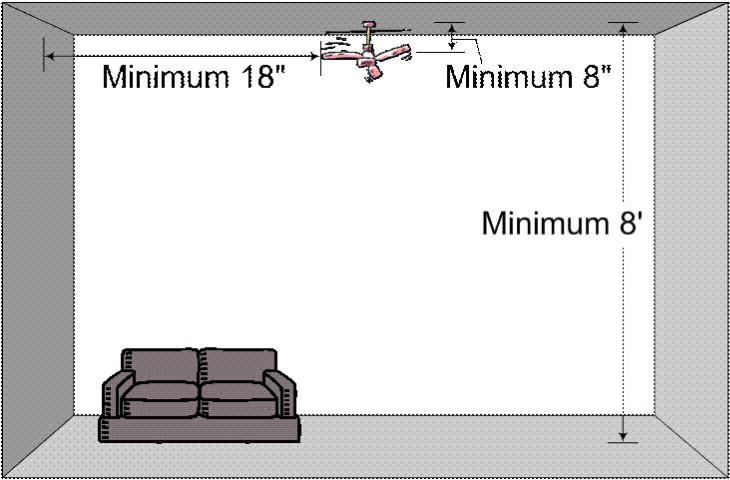Credit: This resource is reproduced in full, with mild formatting and URL hotlink edits, from the fact sheet, UF/IFAS – Energy Efficient Homes: Ceiling Fans (EDIS-FCS3261) [1], by Hyun-Jeong Lee, Kathleen C. Ruppert, Wendell A. Porter, and Randall A. Cantrell [2]
Quick Facts
- Ceiling fans are appliances wrapped decoratively with unique housings in a variety of finishes, and they often feature furniture-grade blades and accessories.
- In the summer, use of a ceiling fan allows for raising the home’s thermostat setting by 4°F without feeling a difference in comfort.
- Most ceiling fans even help in the winter when operated in the reverse direction by forcing warm air near the ceiling down into your occupied area.
- Ceiling fan/light combo kits that have earned the ENERGY STAR® label are about 60% more efficient than conventional fan/light units.
Terms to Help You Get Started
- CFM: Cubic Feet per Minute
- CFM/watt: Cubic Feet per Minute/watt measures air flow efficiency for ceiling fans; the higher the number, the more efficient the unit.
- Downrod: Extension rod that allows you to set the fan at the proper height from your ceiling for optimum performance
- UL: Underwriters Laboratories
Can ceiling fans lower my utility bill?
One of the myths about ceiling fans is that they lower the temperature in a room. Actually, ceiling fans do not lower room temperature. However, they do create a breeze, making room occupants feel cooler and more comfortable. When a ceiling fan is operating, you can usually raise the thermostat setting by up to four degrees during the cooling season with no reduction in comfort. Increasing the room temperature by even two degrees can cut your cooling costs by at least 4%–6%, and in some cases by as much as 8%.
Should I leave ceiling fans running all the time?
No, because fans cool people, not rooms. Ceiling fans are less costly than air conditioning, but they still use electricity. Operating several fans 24 hours a day can add up quickly, especially if no one is home to benefit from them. Operate the fan only when someone is in the room.
What features should I consider?
Correct Sizing
For maximum efficiency, choose a ceiling fan that is the right size for the room. See Table 1 for the guidelines suggested by the American Lighting Association:
Table 1. Fan Sizes Suggested by the American Lighting Association
| Room Size (in ft2) | Suggested Fan Size (diameter) |
| Small (Up to 75 ft2) | 29–36″ |
| Medium (Up to 144 ft2) | 36–42″ |
| Large (Around 225 ft2) | 50–54″ |
Motors
To ensure long life and quiet operation, purchase fans with motor housings constructed with heavier materials, such as die-cast metal. These models tend to produce less vibration and provide better stability for downrods. Also look for models with heavy-duty windings, precision-engineered ball bearings, and shock-absorbent internal components.
Performance-grade fans are designed for continuous, quiet operation. They use larger, more powerful motors, and are generally the most expensive models. Medium-grade models are designed to operate 12 hours or fewer per day, and economy models are designed to operate 8 hours or fewer per day. You will have to do some research to determine fan grades. Check manufacturer’s websites for information.
Motors come either with sealed and lubricated ball bearings, which require little or no maintenance, or with bearings that operate in an oil bath, which will occasionally require you to add oil.
Three-speed motors are recommended for maximum comfort. Most fans (and all ENERGY STAR-qualified models) can reverse direction via a switch on the housing, so that they can move warm air (which rises up to the ceiling) down into the room during the winter.
Blades
Blades should be sealed or finished to prevent moisture-caused damage such as warping, peeling, or tarnishing, especially if the fan will be used in a high-humidity situation. More blades do not necessarily move more air. The pitch (angle of the fan’s blades), balance of the blades, length of the blades, motor design, motor speed, number of blades, etc., are all important in determining how much air a fan can move.
Sound
Try the fan out in the store using all settings to determine how loud it is. If it is too noisy, try a different brand, or a model with blades made of a different material.
Can I install a ceiling fan in any room?
The Energy Efficiency and Renewable Energy (EERE) program at the U.S. Department of Energy indicates that for best performance, ceiling fans should only be installed in rooms where ceilings are 8 feet or higher. They also recommend installing ceiling fans so that the blades are no less than 8 inches from the ceiling and at least 18 inches from any given wall (Figure 1).

Figure 1. Minimum space requirements for a ceiling fan installation recommended by the U.S. Department of Energy. Credit: Image created by Hyun-Jeong Lee in Microsoft Office Visio. Converted to .GIF by IFAS Communication Services. (Click thumbnail to enlarge.)
Do fan/light combination units save energy?

Figure 2. Sample ENERGY STAR logo for use on qualified products only. Credit: Courtesy of ENERGY STAR.
Fan/light units labeled with the ENERGY STAR logo (Figure 2) are about 60% more efficient than standard fan/light units. This can save you $17 per year on utility bills (in addition to the heating and cooling savings gained by operating the fan properly, as described previously). Lights can also be purchased separately as an add-on to a ceiling fan. Most fans accept add-on light kits, though a number of them are only compatible within brands. Check the package for compatibility information. Separately sold ceiling fan light kits should be labeled ENERGY STAR when considering energy efficiency.

Figure 3. Sample ENERGY STAR® Most Efficient logo for use on qualified products only. Credit: Courtesy of ENERGY STAR.
Note that the Environmental Protection Agency (EPA) has a designation ENERGY STAR Most Efficient 2015 (Figure 3). This label recognizes products that deliver cutting-edge energy efficiency along with the latest in technological innovation. The year included on the label designates that the device/appliance meets the criteria for the year indicated. Ceiling fans are one of several appliances/devices that have units meeting these criteria. If interested, begin your search at ENERGYSTAR’s Most Efficient 2015 web page.
Can I use a fan in damp areas?
If you’re installing a fan in a bathroom or other humid location, make sure it is UL-listed with a “damp” rating. If you are mounting a fan where it may come into direct contact with water (e.g., a porch or patio), be sure it has a UL “wet” rating. These fans have features such as sealed or moisture-resistant motors, rust-resistant housings, stainless steel hardware, and all-weather blades (See “Wet/Damp Rating,” ENERGY STAR Ceiling Fan Basics).
What are the current ENERGY STAR ceiling-fan specifications?
The following ENERGY STAR ceiling-fan specifications became effective April 1, 2012:
Table 2. Ceiling Fan Specifications
| Equipment | Specification |
| Ceiling Fans | Specification defines residential ceiling-fan airflow efficiency on a performance basis: CFM of airflow per watt of power consumed by the motor and controls. Efficiency is measured on each of 3 speeds. |
| At low speed, fans must have a minimum airflow of 1,250 CFM and an efficiency of 155 CFM/Watt. | |
| At medium speed, fans must have a minimum airflow of 3,000 CFM and an efficiency of 100 CFM/Watt. | |
| At high speed, fans must have a minimum airflow of 5,000 CFM and an efficiency of 75 CFM/Watt. | |
| Qualifying ceiling-fan models must come with a minimum 30-year motor warranty; one-year component(s) warranty; and a 2-year light kits warranty. | |
| Integral or attachable lighting, including separately sold ceiling-fan light kits, must meet certain requirements of the Residential Light-Fixtures (RLF) specification. See the Qualified Product Information (QPI) form for specific requirements. |
To help you evaluate different ceiling fans with lighting for purchase, go to ENERGY STAR Fans for Consumers and click on the Savings Calculator.
Note that, as of this writing, the U.S. Department of Energy (DOE) has federal design and test procedures for residential ceiling fans but no federal efficiency performance standards. This may be changing in the future as the DOE published a notice in September 2014 announcing that they have conducted a preliminary analysis for the purposes of establishing energy conservation standards for ceiling fans.
ENERGY STAR® Product Finder
The table(s) below offer a real-time list of ENERGY STAR® Certified products related to this fact sheet. Using the vertical and horizontal scroll bars, you can look for specific manufacturer brand names, model numbers, and compare a variety of product specifications and energy performance metrics. Individual columns can be filtered using the column specific “Menu” icons adjacent to their “Information” icons. The entire dataset can be searched using the “Magnifying Glass” icon in the dark grey bar at the top of the table.
Certified Ceiling Fans
References and Resources
American Lighting Association. (n.d.). Selecting a ceiling fan. Retrieved May 6, 2015.
ENERGY STAR. (n.d.a). Ceiling fan basics. Retrieved May 6, 2015.
ENERGY STAR. (n.d.b). Ceiling Fans for Consumers. Retrieved May 6, 2015.
Lawrence Berkeley National Laboratory, Energy Efficiency Standards Group, Energy Analysis & Environmental Impacts Division / U.S. Department of Energy (n.d.) Residential: Ceiling Fans. Retrieved May 6, 2015.
U.S. Department of Energy Energy Saver (n.d.). Fans for cooling. Retrieved May 6, 2015.
Footnotes
[1] This document is FCS3261, one of an Energy Efficient Homes series of the Department of Family, Youth and Community Sciences, Florida Cooperative Extension Service, Institute of Food and Agricultural Sciences, University of Florida. This material was initially prepared in June 2008 with the support of the Department of Environmental Protection, Florida Energy Office, which is now the Office of Energy, Florida Department of Agriculture and Consumer Services. This revised version was prepared May 2012 with the support of the Florida Energy Systems Consortium (FESC) and updated May 2015. Any opinions, findings, conclusions, or recommendations expressed herein are those of the author(s) and do not necessarily reflect the views of the sponsoring organizations. Visit the EDIS website.
[2] Hyun-Jeong Lee, former assistant professor, Department of Family, Youth and Community Sciences; Kathleen C. Ruppert, Extension scientist, Program for Resource Efficient Communities; Wendell A. Porter, lecturer and P.E., Department of Agricultural and Biological Engineering; and Randall A. Cantrell, Assistant Professor, Department of Family, Youth and Community Sciences, Florida Cooperative Extension Service, Institute of Food and Agricultural Sciences, University of Florida, Gainesville, FL 32611.




